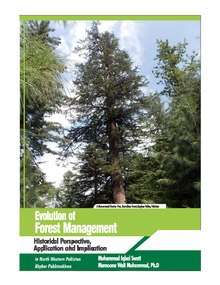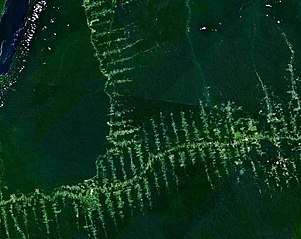Forest management
Forest management is a branch of forestry concerned with overall administrative, legal, economic, and social aspects, as well as scientific and technical aspects, such as silviculture, protection, and forest regulation. This includes management for aesthetics, fish, recreation, urban values, water, wilderness, wildlife, wood products, forest genetic resources, and other forest resource values.[1] Management can be based on conservation, economics, or a mixture of the two. Techniques include timber extraction, planting and replanting of different species, cutting roads and pathways through forests, and preventing fire.

Definition
The forest is a natural system that can supply different products and services. The working of this system is influenced by the natural environment: climate, topography, soil, etc., and also by human activity. The actions of humans in forests constitute forest management. In developed societies, this management tends to be elaborated and planned in order to achieve the objectives that are considered desirable.
Some forests have been and are managed to obtain traditional forest products such as firewood, fiber for paper, and timber, with little thinking for other products and services. Nevertheless, as a result of the progression of environmental awareness, management of forests for multiple use is becoming more common.[2]
Public input and awareness
There has been increased public awareness of natural resource policy, including forest management. Public concern regarding forest management may have shifted from the extraction of timber for earning money for the economy, to the preservation of additional forest resources, including wildlife and old growth forest, protecting biodiversity, watershed management, and recreation. Increased environmental awareness may contribute to an increased public mistrust of forest management professionals.[3] But it can also lead to greater understanding about what professionals do for forests for nature conservation and ecological services. The importance of taking care of the forests for ecological as well as economical sustainable reasons has been shown in the TV show Ax Men.
Many tools like GIS and photogrammetry[4][5] modelling have been developed to improve forest inventory and management planning.[6] Since 1953, the volume of standing trees in the United States has increased by 90% due to sustainable forest management.[7]
Wildlife considerations
The abundance and diversity of birds, mammals, amphibians and other wildlife are affected by strategies and types of forest management.[8]
Management intensity
Forest management varies in intensity from a leave alone, natural situation to a highly intensive regime with silvicultural interventions. Forest Management is generally increased in intensity to achieve either economic criteria (increased timber yields, non-timber forest products, ecosystem services) or ecological criteria (species recovery, fostering of rare species, carbon sequestration).[9]
See also
- Biodiversity
- Certified wood
- Community forestry
- Conservation biology
- Coppicing
- Edmund Zavitz
- Environmental protection
- Even-aged timber management
- Forest farming
- Forest informatics
- Forest inventory
- Forest plans
- Growth and yield modelling
- Habitat conservation
- Healthy Forests Initiative
- Natural environment
- Natural landscape
- Nature
- Outline of forestry
- Overexploitation
- Renewable resource
- Sustainability
- Sustainable development
- Sustainable forest management
- Van Vigyan Kendra (VVK) Forest Science Centres
- Proforestation
References

- "Glossary of Forestry Terms in British Columbia" (pdf). Ministry of Forests and Range (Canada). March 2008. Retrieved 2009-04-06.
- Young, Raymond (1982). Introduction to Forest Science. John Wiley & sons. p. 207. ISBN 978-0471064381.
- Shindler, Bruce; Lori A. Cramer (January 1999). "Shifting Public Values for Forest Management: Making Sense of Wicked Problems". Western Journal of Applied Forestry. 14 (1): 28–34. ISSN 0885-6095. Retrieved 2008-08-25.
- I. Balenovich, A. Seletkovich, et al. Comparison of Classical Terrestrial and Photogrammetric Method in Creating Management Division. FORMEC. Croatia 2012. pp. 1-13.
- I. Balenović, D. Vuletić, et al. Digital Photogrammetry – State of the Art and Potential for Application in Forest Management in Croatia. SEEFOR. South-East European Forestry. #2, 2011. pp. 81–93.
- Mozgeris, G. (2008) “The continuous field view of representing forest geographically: from cartographic representation towards improved management planning”. S.A.P.I.EN.S. 1 (2)
- The Value of Hardwood Floors
-
- Philip Joseph Burton. 2003. Towards sustainable management of the boreal forest 1039 pages
- Classification of Forest Management Approaches: A New Conceptual Framework and Its Applicability to European Forestry Philipp S. Duncker 1, Susana M. Barreiro 2, Geerten M. Hengeveld 3, Torgny Lind 4, William L. Mason 5, Slawomir Ambrozy 6 and Heinrich Spiecker 1|http://www.ecologyandsociety.org/vol17/iss4/art51/